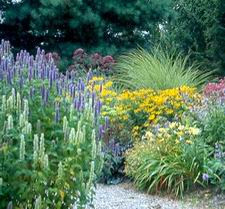
I’ve been reading lots of blogs and I’ve determined that I have to do something bold to grab your attention, so here goes:
[BOLD LEAD PARAGRAPH]
Dear “The Scotts and Miracle-Gro Company”:
I don’t hate you. I’ve never even met you--not that I’m aware of. I just hate what you stand for. You’re not alone in keeping us shackled to the questionable ideal of the suburban lawn—just kinda the big target with the “kick-me” sign, so I’m picking on you because it’s easy.
Per your web site, it is heartening to see you giving a small nod to using organic materials. Of the 13 products shown on your lawn fertilizer page, the Scotts Organic Choice looks pretty lonely. At least you’re trying to build a little green “street cred”, but we know where your real profits come from and which products get all your promo bucks.
I guess my gripe is that you live and thrive by helping to sustain the myth that a “real” garden has to have “thick, lush, green turf” even if nature and the environment continually remind us that without your toxic products, copious amounts of precious water, herbicides and insecticides we might succumb to YELLOW LEAVES!, NASTY BUGS! (don’t want any of THOSE near our kids) and the silent scorn of our neighbors.
[Pretty damn bold, eh? I’m waiting for their corporate jack-booted thugs to come pound on my door.]
TRANSITION (can’t suddenly switch gears…I have to back my way into the real content)
My last two blogs have set the stage for murdering your lawn and lots of readers seem to want to take it to the next level. I’d love to help, but first a disclaimer. My 35-year experience in the green industry and landscape architecture is from a career based in the benign coastal climate of central and southern California. So when I’m asked by readers from around the country to help them with lawn alternatives the first problem that arises is finding appropriate plants for your specific locale. The environmental and cultural conditions are just too varied for me to claim to be all things to all readers.
SUBSTANCE (here’s the payoff)
So how about I just do some coaching to help you move in the right direction? It’s gonna take me a few more postings to get you there (I just moved to a new home, so writing time is a bit scarce) but keep checking in and I’ll try to get you where you’re going. I also welcome any comments based on your own experiences. Just tell us where you’re writing from.
First things first—are you REALLY going to remove every blade of grass from your current lawn? Do you really need to? Form follows function, so if you’re doing this because you’re just tired of the work and environmental impacts of being a recovering lawn owner, do you have to actually remove the lawn? What if you just tinker with it and let it revert a Darwinian approach? I think that’s still taught in some schools—Survival of the Fittest.
What if you just stopped mowing and watering? What would move in to fill the void? Nature abhors a vacuum, so something is going to find these new conditions very attractive. Yes, the weeds you’re currently keeping at bay might take advantage, but not necessarily. If the watering stops and you rely only on natural rainfall, some of those weeds that thrived on the life-support you provided for your lawn just might give up.
What if you introduce a few new non-turfgrass plants? Here in Santa Barbara, I’d be looking at things like creeping thyme (Thymus serpyllum), Lippia (Phyla nodiflora), some sedges like Carex praegracillis, English daisy (Bellis perennis) or common yarrow (Achillea millefolium). My local favorite to mix in is Blue-eyed Grass (Sisyrinchium bellum), shown in the photo at the beginning of this post. Now where you live, these might not grow, or they might become noxious weeds (Lippia is a scourge in New Zealand).
Your assignment this week: Do your homework by finding some plants that you can allow to infiltrate your current lawn, and start thinking of it as a naturalized meadow. Visit a garden, check your plant catalogs, talk to some experienced gardeners. Let me know what you find.
I’ll be back soon. Promise.


